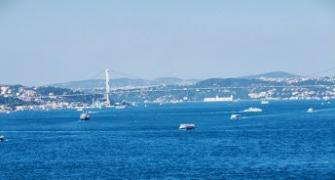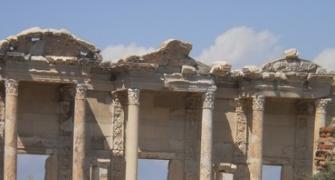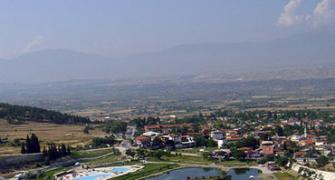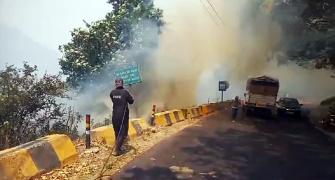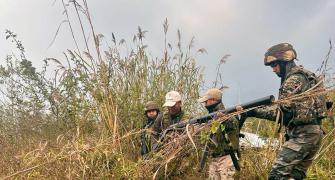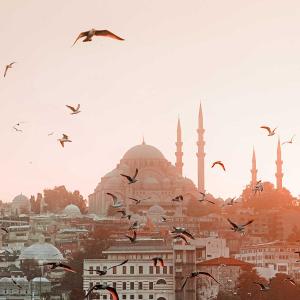Letika Saran and her group continue their adventure through Turkey heading for some of the country's most scenic parts -- Cappadocia and Ephesus.
Read the first part: Istanbul: Memories And The City.
Early morning saw all of us set off on the next phase of our journey, first to Cappadocia.
There was one badly swollen foot amongst us in desperate need of a pair of sandals. But not a shop to be found!
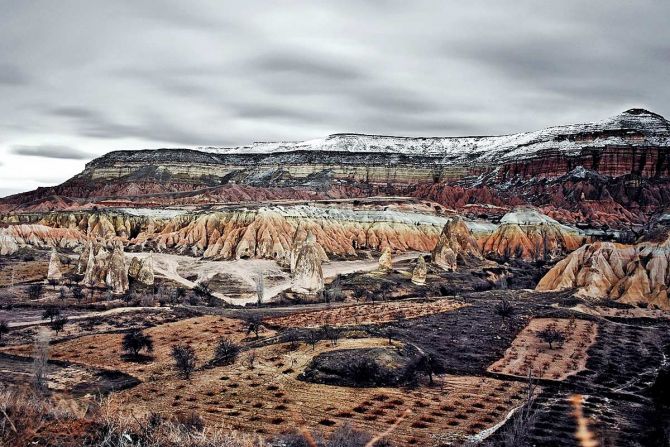
On alighting at Kayseri airport, we drove to the picturesque town of Goreme, which actually had a whimsical landscape, made of volcanic pumice from Mount Erciyes and two other volcanoes aeons ago and basalt rocks.
Obelix's menhirs dotted the place -- some were tombs. The new buildings, the old, strangely-shaped menhirs and caves stood side by side.
Our hotel too, like others, had rooms carved from the caves, which could take up to two years to complete. No two rooms were alike, apart from having no covered storage space. But the circular bed in one did make life more entertaining for the young-at-heart couple!

The highlight of our trip and our visit to Cappadocia was the anticipated hot air balloon ride. But it was not to be, thanks to the windy conditions above.
The view from our hotel terrace and the fabulous breakfast spread eased the disappointment a little.
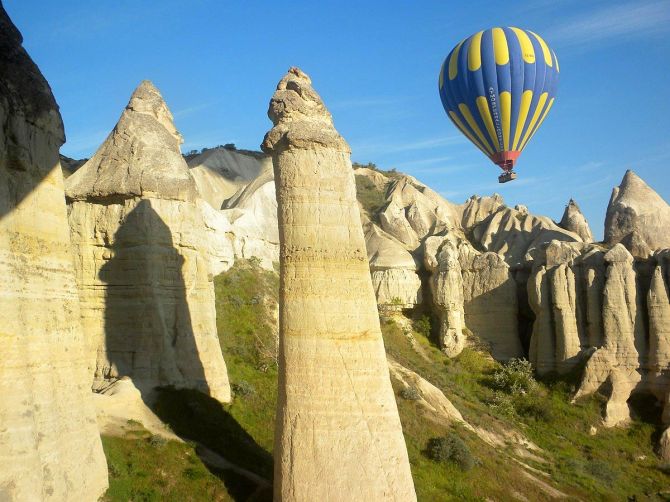
Baki, our guide, took us on a short trip into another world of the fairy chimneys and rock formations in Pasabag, as well as Monks valley and Devrent valley.
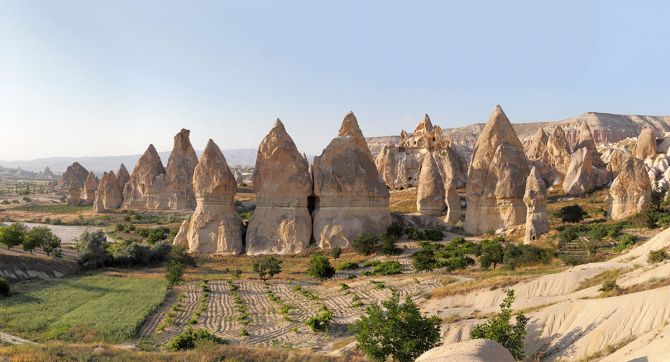
The fairy chimneys looked like toadstools perched on a tall rock, thanks mainly to the vagaries of the weather.

The rock structures brought our imaginations to life, and activated those genes, as we saw a camel, a dancing couple and more in the formations.

The caves hid people when the invaders came, mostly from Macedonia, an old kingdom on the Greek peninsula. Many of the caves served as monasteries or refuges, where the monks stayed when fleeing from these raiders.
The most intrepid amongst us climbed up to as high a level as we could handle for a first-hand experience. Needless to say this was an adventure not to be repeated!
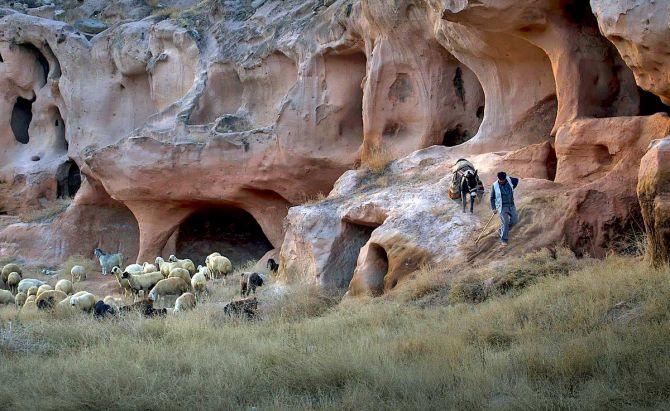
The Özkonak Underground City, in Nevsehir province, was probably built by the Hittites, ancient Anatolian or Indo-European people arriving in that area around 1650 BCE -- the idea was to escape the extremities of the weather. Later it was a refuge from the Phrygians, invaders who swept in from the Balkans, and then for the Phrygians from the Macedonians.
It could easily house 60,000 people for three months. Only one-fourth of the area had been excavated and went down four floors, which gave a pretty good picture.
The animals were housed nearest to the exit and thereafter the kitchen, with its version of the tandoor buried into the floor and then the store and winery.
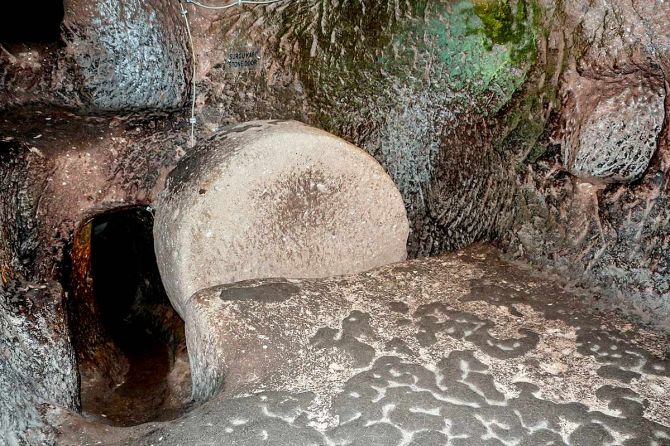
The most interesting features were the pipes which were built vertically for ventilation and communication. And the millstone door used to keep intruders out. Five of us together could not move the door an inch!

A visit to this part of the country was not done without a trip to the pottery and ceramic factory and their showrooms in Avanos and the zultanite factory nearer Goreme. Zulanite is a rare gem found only in Turkey, considered lucky, that has a varying colour -- it can be yellow, gold, pinkish-purple or even light green.
The potter's wheel, used around there, was one that was spun using one's feet. And though the guy demonstrating made it look easy, none of us were ready to take up the challenge.
The ceramics, especially the wine bottles shaped like doughnuts with a spouts on top and handles, were exquisite.

A sip of salep or tea made from orchids was surprisingly good.
Equally interesting were the nooks for pigeons carved out of the rocks in Pigeon valley. Pigeons were important in Cappadocia for their use as messengers, then for the fertiliser from their excreta and thirdly their egg shells were crushed and used as plaster for the frescos in the churches.
The food at the restaurants we went to in Goreme was really good -- whether meat or vegan; even their speciality, 'pot' kebab. And the potato finger chips were to die for!
From Cappadocia we headed to Izmir via Istanbul (long journey). But once we landed in Izmir and set off for Kusadasi, every bit of tiredness vanished. We drove through groves of olives, peaches and greenery which was as different as could be from Cappadocia.
Our hotel faced the sea, where many cruise ships had docked.
A very late lunch at one of the wayside restaurants was superb and a few of us worked off the extra calories walking through the waterfront shopping arcades.
Gufte, our guide for the day, met us, with her understudy Daria, and we set off for a visit to Mother Mary's last resting place or where the Bible says she relocated to, with John the Apostle, to whom she had been entrusted by Jesus.
We wound our way up a hill to Ephesus, past souvenir shops, to an open-air chapel where mass was held on Sundays. Just beyond was the house, which centuries back would have been a single-roomed place. What distinguished it from other houses, and also indicated that the locals held Mother Mary in high esteem, was the pipes which carried clean water to her humble abode.
The inside of the house was redecorated and done up as a shrine, while the exterior remained, with the old stone. The walk back went via springs of holy water and the wishing well. All of us drank at the fountains and tied our wishes to the frame in the wall.
The person/s who wrote the all-important signboards directing folks to the restroom had a great sense of reality, tinged with humour. The expression of each person who reached the restrooms mirrored the sign -- 'Desperate to go!'

We walked down to city of Ephesus, which dated from Greek and Roman times. Established in 10th century BCE by the Greeks it came under Roman control in 129 BCE. Ephesus' streets were laid out rectangularly and its theatre, libraries, the agora (public spaces), marketplace, enormous baths and gymnasiums, stoas (covered promenades) and all other key public buildings were built acorss this grid. The theatre could seat 25,000 and was finished in Roman emperor, Trajan's time.
Earthquakes, which are a way of life in this area, had been responsible for most of the damage to the site. But there was still much to tell us about the way of life of those who once lived here, who enjoyed fresh running water brought by earthenware pipes through to the public toilets, where the affairs of the day were discussed while relieving oneself!

Our walk started out at the gymnasium, where young boys studied, and near the Domitian Temple (one of the first dedicated to a human ie to Roman Emperor Domitian).
Like important politicians of old we reached the Odeon, a relatively small amphitheatre, with excellent acoustics. This naturally encouraged some tourists, including us, to burst into song (Waltzing Matilda).
There were slabs with figurines that were being restored, like that of Nike, the goddess of victory; Hermes, messenger of the gods; and Hygenia, the high priestess of health.
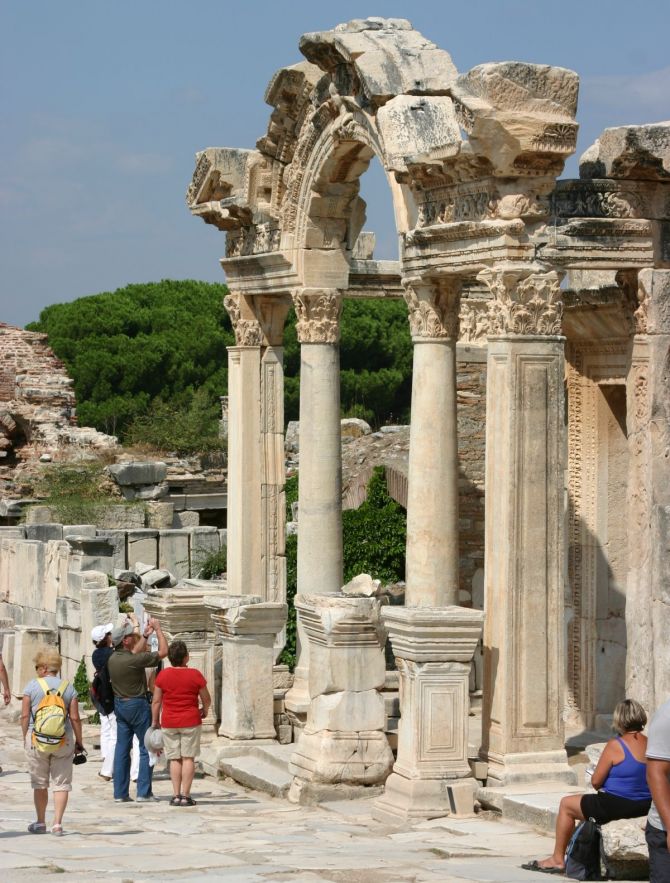
The reconstructed Temple of Hadrian had two main arches up, with the face of Tyche, the Greek deity for fortune on top, and that gave a sense of what the temple would have been like.

One of the most impressive structures being restored is the Library of Celsus, the facade of which has been carefully reconstructed from original pieces.
It was originally a three-storeyed structure, with the third floor made of wood that was totally damaged. Next to it was the State Agora or place of commerce built by the Romans.

More interesting was the 'Love House', which stood opposite the library, that could be accessed by many a studious scholar through the secret tunnel to it!!
Gufte also showed us the plaque with a footprint pointing the way to the brothel!

As we walked down, we saw a beautiful flowering Judas tree. This naturally called for a photo op.
And then the way lead down to Ephesus' amphitheatre, one of the largest old-world structures, that was the venue of dramatic performances and much later for gladiatorial fights.
With this final stop, we moved out of the ancient city.
A visit to the local crafts areas was a must. The first was the Porque showroom which sold leather garments. A short fashion show, where the double-sided jackets were displayed, had the desired outcome -- there is a little girl up in the hills in India who is the proud owner of one such jacket.
The craft village of Sirince offered local produce, like soaps in the form of fruits, olive oil and mulberry wine, aside from the mouthwatering ice cream, served to all who passed by.
The ice cream cone was instrumental in allowing the 'octopus' amongst us to display her ability to knock things down!
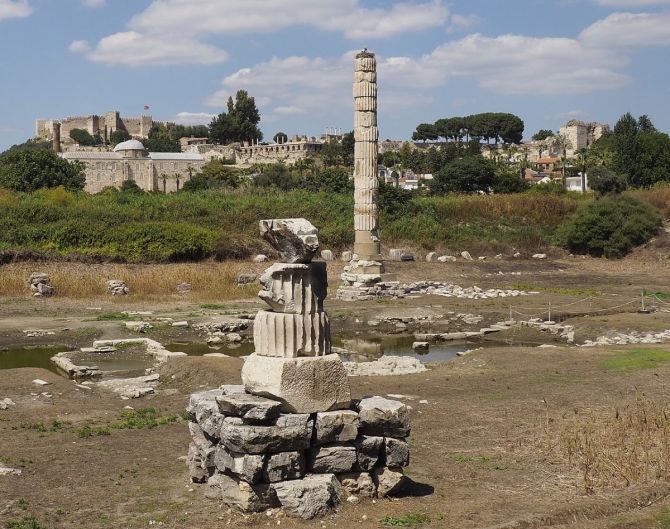
Before leaving Ephesus we went to the Temple of Artemis nearby. This is one place where your imagination has to actually take flight trying to picture the temple from the one solitary pillar that had been put together.
Being in an earthquake-prone area does not help.

Our penultimate day saw us fly back to Istanbul and finish a round of last minute shopping -- the men headed to the spice market, while three of us walked down from the now familiar eatery Ibrahim Pasha to the small and well organised Astha market.

On our return to the hotel we went up to the terrace -- something that we had not been able to do thanks to the rain -- to look into Topkapi Palace from the kitchen side and beyond at the six minarets of the Sultanahmet or the Blue Mosque.

The only unhappy soul was the seagull, who had laid her eggs in one of the flowerpots and did not want the pesky photographers around!
And then it was time... Güle güle Türkiye!
Letika Saran, retired director general of police, Tamil Nadu, enjoys visiting new places with family and friends.
Feature Presentation: Ashish Narsale/Rediff.com


